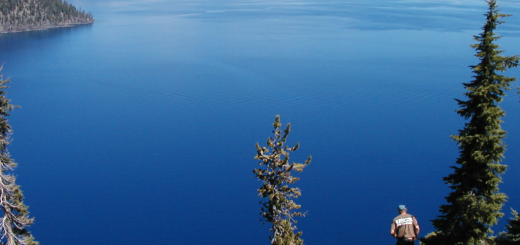Lakes Made By Meteors
8We have covered our share of crater lakes. Most have been formed thanks to angry and violent volcanic eruptions that blew out large portions of Earth that eventually filled back in with water. But there are other kinds of crater lakes on our planet, formed with help from bodies completely alien to our world. In this short roundup, we take a look at five crater lakes made by meteors that fell suddenly yet left lasting impacts.
All of the crater lakes in our list are special in their own way, but sorting them proved difficult because their shapes are largely uniform. Falling meteors seem to do a good job of leaving very circular deformations in Earth’s surface and that is the shape most on our list have taken. Since there weren’t a lot of visual elements to separate them and because we wanted to add a little countdown fun, we’ve sorted them by impact crater size.
We start with the smallest and work our way to No. 1.
5. Lonar Meteorite Crater, Deccan Plateau, India
Lonar Lake is a saline soda lake in India created by a meteor impact during the Pleistocene. That lasted from about 2.5 million years ago to 11,700 years ago and contains the most recent period of glaciations. It has been extensively studied by U.S. and Indian researchers, some of whom discovered in 2007 that nitrogen fixation occurs in the lake. It is only 3,900 feet in diameter, on average, and 450 feet deep.

Lonar Lake. (Credit: NASA)
4. Pingualuit Impact Crater, Quebec, Canada
This crater lake was also formed during the Pleistocene, when a meteor struck the Ungava Peninsula of Quebec, Canada. It sat undiscovered until the 1900s, before which it was prominent for Inuit peoples who called it the “Crystal Eye of Nunavik” for its crystal water. In 2007, Laval University scientists visited it to take insect and sediment samples. Their coring efforts revealed at least two glacial periods. Pingualuit Lake is 2.14 miles in diameter and 1,300 feet deep.

Pingualuit Lake. (Credit: NASA)
3. Lake Jänisjärvi, Karelia, Russia
Russia’s Lake Jänisjärvi (Yanisyarvi) is located north of and drains to Lake Ladoga. Its crater was formed during the Cryogenian period and was thought to be a volcanic crater for years prior to World War II. The lake is 8.7 miles in diameter and not as circular in shape as others on our list.

Lake Jänisjärvi. (Credit: NASA)
2. Lake Siljan, Dalarna, Sweden
Lake Siljan is the largest known impact crater in Europe outside of Russia and holds Sweden’s sixth largest lake. It was formed 377 million years ago by a major meteorite impact during the Devonian period. That period was marked by small plants dominating land, while oceans were dominated by brachiopods and corals that built large reefs. Lake Siljan’s max depth is 390 feet and had an estimated diameter of 32 miles at its formation.

Siljan impact crater. (Credit: Public Domain)
1. Manicouagan Reservoir, Canada
Manicouagan Reservoir is an annular (ring-like) lake in central Quebec, Canada. It is the fifth largest reservoir in the world by volume and is thought by some to be a wonder of Canada. Its water lies in an ancient impact crater made by an asteroid more than 3 miles in diameter. Because of post-impact uplift, land has surged up at its center, creating an interesting effect some call the “eye of Quebec.” Manicouagan Reservoir is 60 miles in diameter and has an average depth of 279 feet.

Manicouagan Reservoir. (Credit: Public Domain)
Know of any other crater lakes made by meteors? Are there a few that belong on our list? Please consider leaving a comment to share your thoughts!














what about Elgygytgyn?
Lappajärvi at Finland is also a crater lake.
[…] have the Himalayas and snow as well as deserts, plateaus and valleys. We have one of only 5 crater lakes in the world, here in Maharashtra. We have the world’s largest Banyan tree in […]
Lake Bosomtwe – Ghana
There is a lake in the Muskoka area in Ontario Canada. Skelton lake. It is apparently a lake created by a meteorite. It is said to be unique because of its limestone lining. In 1990s at some point it was tested to have no mercury which I think is uncommon for the area. It is unfortunate that at this time the community is fighting to stop a rock quarry from going I. About a mile from the lake. Residents fear the blasting could damage the limestone crust and lead to contamination of the lake. If you have any ideas to support their protection cause your advice would be greatly appreciated.
I was looking up something else in the Skagway/ Haines Alaska area and noticed a long narrow, Lake Dease. When I pulled the image back I noticed another lake, Halfmoon Lake. There appears to be a couple of half moon lake in Canada but this one is located at 58°42’26.5″N 129°55’27.8″W. It is about Six (6) miles east of Laketon on the west side of Lake Dease. I think Halfmoon Lake is an old impact crater because if the very roundness of the parts of the lake.
I have watched several shows on NatGeo or Science Channel having to do with impact sights and it looks like images I’ve seen there.
Hope the search confirms my suspicions.
Frank
How about Teal Lake, minnesota
Lake Bosomtwe in Ghana is a meteorite lake too.